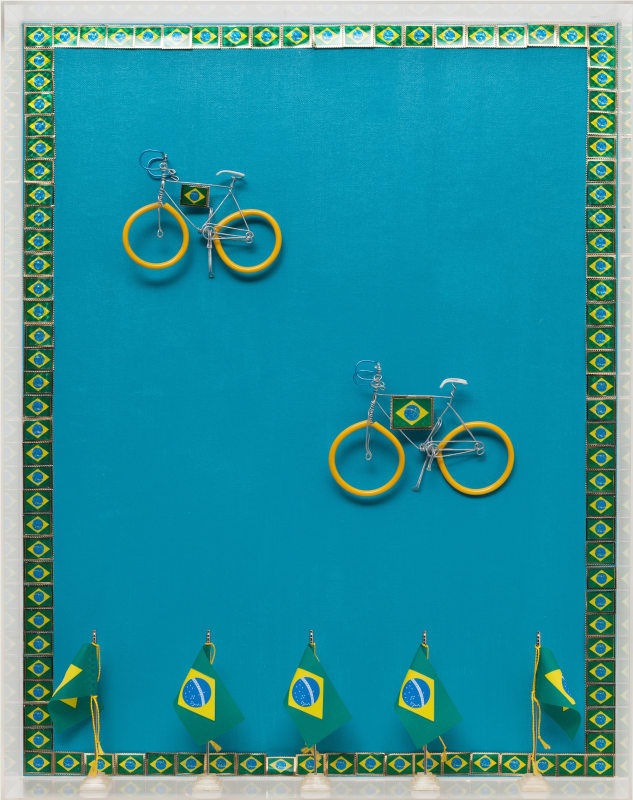Nelson Leirner (São Paulo, SP, 1932 - Rio de Janeiro, RJ, 2020). Intermedia artist and university professor. His works and actions are characterized by their reflective and polemical content. Alternating between political and social criticism, references to art and the market, and references to divinities and animals, he transforms everyday objects into allegories of the situations he intends to emphasize.
Son of sculptor Felícia Leirner (1904-1996) and businessman Isaí Leirner (1903-1962), he has had contact with modern art since childhood. His parents helped found the Museu de Arte Moderna de São Paulo (MAM/SP) and were familiar with much of the Brazilian avant-garde. This proximity, however, did not immediately awaken Leirner's interest in art.
He lived in the United States from 1947 to 1952, where he studied textile engineering at the Lowell Technological Institute in Massachusetts, but he did not complete the course. He decided to become an artist only in the 1950s, stimulated by the works of painter Paul Klee (1879-1940). In 1956, he took painting classes with the Catalan artist Joan Ponç (1927-1984), and in 1958 he attended, for a short time, Samson Flexor's (1907-1971) Atelier-Abstração. He was not enthusiastic about the courses. His paintings approached the informal abstraction of painters such as Alberto Burri (1915-1955) and Antoni Tàpies (1923-2012).
Between 1961 and 1964, he continued his research into materials, but in a different direction. Interested in Dadaist poetics, he produced his paintings with objects collected in the street, generating the series Apropriações. In 1964, the artist abandoned painting and began to work with industrial ready-made elements. He collected useful objects and shifted their meaning, as in Que Horas São D. Candida (1964). His works were somewhere between sculpture and object.
The spectator's participation was incorporated into works such as Você Faz Parte I and II, (1966). That same year, he founded the Grupo Rex, with artists Wesley Duke Lee (1931-2010), Geraldo de Barros (1923-1998), Carlos Fajardo (1941), José Resende (1945) and Frederico Nasser (1945). The collective promoted happenings and published the newspaper Rex Time. The group focused on problems such as art's relations with the market, institutions and the public, all of which are approached based on the radical languages of the 1960s.
In 1967, he held the exhibition Da Produção em Massa de uma Pintura. He showed Homenagem a Fontana, one of the first series of multiples in the country. The "paintings" were industrially produced, made of zippers and fabrics, objects that traditionally have no artistic value. That same year, he sent his Porco Empalhado (1966) to the 4º Salão de Arte Moderna de Brasília. The jury accepted the work. Leirner questioned the result and publicly requested, via the newspaper Jornal da Tarde, an explicit statement of the show's admission criteria, creating a polemic with critics such as Mário Pedrosa (1900-1981) and Frederico Morais (1936), which is known as the "critics' happening. Also in 1967, he held the Exposição-Não-Exposição, a happening to close Rex Group's activities, in which he offered works of his own authorship free of charge to the public.
He made his first multiples, with canvas and zipper over chassis. He is also one of the pioneers in the use of the billboard as a support. For political reasons, he closed his special room in the 10ª Bienal Internacional de São Paulo in 1969, and refused an invitation to another edition, in 1971.
From the 1970s on, the questioning content of the work migrated from direct action to an allegorical sense, which often involved eroticism. The happening became less present than drawing and installation. At this time, Leirner turned to other languages, such as design, multiples, and experimental cinema, and created great allegories of the contemporary political situation in series of drawings and prints. In 1974, he exhibited the series A Rebelião dos Animais, with works that harshly criticized the military regime, for which he received the best proposal of the year award from the Associação Paulista dos Críticos de Arte (APCA).
In 1975, APCA commissioned a work from him to be awarded to the winners, but then refused it because it was made as Xerox photocopies. Therefore, in protest, the artists did not attend the event. From 1977 to 1997, he taught at Fundação Armando Álvares Penteado (Faap), in São Paulo, where he was very relevant to the education of several generations of artists.
The presence of elements of Brazilian popular culture, evident since the 1960s, grew from the 1980s on. In 1985, he created the installation O Grande Combate, in which he used images of saints, Afro-Brazilian deities, children's dolls, and replicas of animals. He intended to convert whatever was considered trivial into art.
He moved to Rio de Janeiro in 1997, and coordinated the basic course at Escola de Artes Visuais do Parque Lage (EAV/Parque Lage). As of the 2000s, his work appropriated artistic images banalized by consumerism. In a good-humored way, he dealt with reproductions of the Gioconda [Mona Lisa] (1503/1506), by Leonardo da Vinci (1452-1519), and the Fountain (1917), by Marcel Duchamp (1887-1968), as artistic themes. With the same irony, the artist replicated images from the Brazilian concrete tradition on ox leather, in the series Construtivismo Rural.
With a prolific career of heterogeneous works with a critical and reflective content, Leirner became, as an artistic producer and educator, an important figure in the development of modern art in Brazil.
NELSON Leirner. In: ENCICLOPÉDIA Itaú Cultural de Arte e Cultura Brasileiras. São Paulo: Itaú Cultural, 2021. Available at: <http://enciclopedia.itaucultural.org.br/pessoa9429/nelson-leirner>. Accessed on: June 14, 2021. Encyclopedia entry. ISBN: 978-85-7979-060-7

